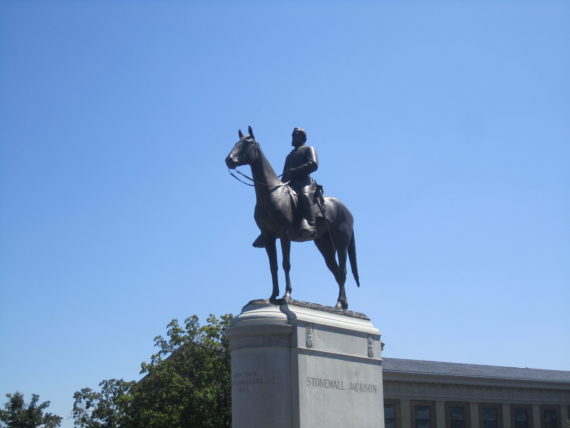On 28 August 2017, the American Historical Association (AHA) issued a “Statement on Confederate Monuments” that presumed to speak for the entire American historical profession on the issue of whether these monuments should remain or if they should be removed from public spaces.
Unfortunately this “statement” is little more than historical establishment claptrap disguised as highbrow intellectual discourse—par for the course in the modern profession—replete with distortions, exaggerations, half-truths, and presentism myths.
The “statement” opens by suggesting that the AHA “welcomes the emerging national debate about Confederate monuments…” but suggests that “Much of this public statuary was erected without such conversations, and without any public decision-making process.”
The “statement” later concludes by asserting that “Nearly all monuments to the Confederacy and its leaders were erected without anything resembling a democratic process. Regardless of their representation in the actual population in any given constituency, African Americans had no voice and no opportunity to raise questions about the purposes or likely impact of the honor accorded to the builders of the Confederate States of America.”
Both arguments are disingenuous at best. The “public statuary” in question did involve conversations both North and South, not just about Confederate monuments, but about general American iconography, and every monument involved some type of “public decision-making process.”
Nearly all of the funds raised for Southern monuments came from private donations. Women’s organizations sought pennies to help fund relief enterprises, including finding artificial limbs for Confederate veterans. They also hoped to erect monuments for the dead. Republican controlled governments, military occupation, and lack of capital put off many of these projects until the several years after the War, but by the 1870s, monuments to Confederate soldiers began appearing in towns and cities across the South. One of the first was constructed of wood in Columbus, Georgia’s Linwood Cemetery. In fact, the vast majority of these monuments were erected in cemeteries until the turn of the twentieth century, but even as the monuments began to be placed in public locations, most were dedicated to the common Confederate soldier, not individuals.
But this was not just a Southern movement. Across the United States during the Gilded Age and Progressive Era, Union veterans organizations began constructing monuments as well, and these, like their Southern counterparts, focused on the heroism and sacrifice of the Union dead. There was no animus between erstwhile foes. New Yorker Cornelius Vanderbilt, at the insistence of his Southern wife Frank, funded several charitable causes that benefitted exclusively Confederate veterans. By the early twentieth-century, some Northern monuments had the financial backing of the federal government. The now vilified Stone Mountain carving in Georgia had to rely on private donations while the more famous Mount Rushmore carving in South Dakota had federal funding. Northern and Southern taxpayers subsidized the Lincoln Memorial in Washington D.C. while the monument to Jefferson Davis in Richmond was built by private donations. All were part of public beautification projects in a progressive effort to reconcile the sections.
Booker T. Washington thought these memorials and monuments were worthwhile. In 1914, he agreed to help find funding for the Confederate monument in Opelika, AL, saying that, “We all realize more and more that men like him [Confederate Veteran George Paul Harrison, Jr.] are true friends of our race, and that any monument that will keep the fine character of such heroes before the public will prove helpful to both races in the South.” Washington was African-American and both had a voice and “an opportunity to raise questions about the purposes or likely impact of the honor accorded to the builders of the Confederate States of America.” He made clear he thought such monuments would “prove helpful to both races in the South.” Black Americans often attended unveiling events and when Jefferson Davis and John B. Gordon traveled through Alabama and Georgia after the cornerstone ceremony for the large Confederate sculpture in Montgomery, thousands of black Southerners lined up to see the procession.
The AHA “statement” contends that, “History comprises both facts and interpretations of those facts. To remove a monument, or to change the name of a school or street, is not to erase history, but rather to alter or call attention to a previous interpretation of history.” Curiously, the “statement” then argues, “A monument is not history itself; a monument commemorates an aspect of history, representing a moment in the past when a public or private decision defined who would be honored in a community’s public spaces.”
Part of this is true. History is interpretation, and the AHA is willfully engaging in a bit of historical revisionism in its “statement.” The AHA correctly states that most of the monuments were built in the decades after the War, but then claims, “this enterprise was part and parcel of the initiation of legally mandated segregation and widespread disenfranchisement [sic] across the South. Memorials were intended, in part, to obscure the terrorism required to overthrow Reconstruction, and to intimidate African Americans politically and isolate them from the mainstream of public life.” For an organization that insists all statements like this should be “rooted in evidence and disciplinary standards,” they fall far short of meeting their own objectives.
In the hundreds if not thousands of memorial address, dedication ceremonies, and public events held to unveil a monument or commemorate the Confederacy in the postbellum South, very few, if any, spoke of “white supremacy” or the attempt to “terrorize” and “intimidate African Americans politically and isolate them from the mainstream of public life.” Memorial addresses spoke of the heroism and sacrifice of the soldier, the dedication of Southern women, and the principles of liberty and independence, and most expressed satisfaction that slavery had been abolished for the good of humanity.
For example, at the 1915 cornerstone ceremony for the Stonewall Jackson monument in Richmond, VA, William A. Anderson, a Lexington, VA native, Confederate veteran, and member of the Stonewall Brigade, said that the Jackson statue would memorialize “The example which he [Jackson] gave the world of self-sacrificing devotion to principle and to country, of loyal obedience to duty, and unquestioning faith in God, the unsurpassed manifestations of courage which he exhibited, and the radiance with which his genius illumined the fields of his triumphs….” Anderson believed these traits would “compel the admiration alike of friend and foe, and constitute a part of the patrimony of glory, not of Virginia and the Confederate South alone, but of the American people and the human race.” The hate for anyone other than white Southerners clearly seethed from Anderson’s pores.
As to the statement that such monuments are “not history,” that defies the value of such monuments as works of art. Is the Lincoln Memorial only a “monument?” What about Mount Rushmore? Or the Washington Monument? Do they not constitute something other than a monument? The AHA stands behind the Washington Monument and would not want to see it removed to “a museum or some other appropriate venue” as in the case of Confederate monuments. The AHA further thinks “Americans can also learn from other countries’ approaches to these difficult issues, such as…Memento Park in Budapest, Hungary.” Most Americans would not recognize the loaded symbolism of this statement. Memento Park is filled with statues and monuments to the Soviet Union and communism. In other words, Confederate monuments are as illegitimate as the Soviet empire, as bloody as Marxism, and constitute a foreign part of American history. They are not American. No bias there.
Perhaps the most bizarre section of the “statement” is where the AHA contends that, “Decisions to remove memorials to Confederate generals and officials who have no other major historical accomplishment does not necessarily create a slippery slope towards removing the nation’s founders, former presidents, or other historical figures whose flaws have received substantial publicity in recent years.” This is simply not true. See attacks made on the George Washington and Andrew Jackson statues in New Orleans, the attempt to rename James Madison High School in Wisconsin, the vandalism of a Christopher Columbus statue in New York, calls for the removal of the Thomas Jefferson statue at UVA, or the actual removal of the Richard Stockton bust at Stockton University. And this is only the beginning. No slippery slope? The AHA is delusional or maybe just overtly political. This part of the statement could have been written by “distinguished” historian Annette Gordon-Reed, whose pseudo-history of the (debunked) Jefferson-Hemings affair earned her a Pulitzer Prize. See the Jefferson Hemings Scholars Commission. Gordon-Reed laughs at the idea that the founding generation is next because “We can distinguish between people who wanted to build the United States of America and people who wanted to destroy it….” Never mind that many of the prominent leaders of the Confederacy were descendants of Southern founders and that the United States continued to exist in 1861 even without the Southern states. To Reed and other “distinguished” members of the AHA, Confederate leaders and veterans are not worthy of recognition.
I have never joined the AHA, and I would encourage other historians who take issue with their recent “statement” to reconsider sending another dime to a historical organization that clearly cares little for “evidence and disciplinary standards” in its own publications.







